Want to be more efficient with your griddle? You came to the right place.
After years and years of cooking on a flat top, I’ve discovered and developed several techniques that have made my life easier.
I want to share these with you, especially newcomers, so you’ll fully take advantage of your flat top grill from the start so you won’t have to struggle with it as I did.
Now, I already made a list of tips and tricks in my previous article. I did mention most but not everything. This serves as a quick summary. I suggest this for everyone who doesn’t have the time nor the will to read long texts.
Flat Top Grill Cooking Tips and Techniques
Know What Can You Cook on a Griddle
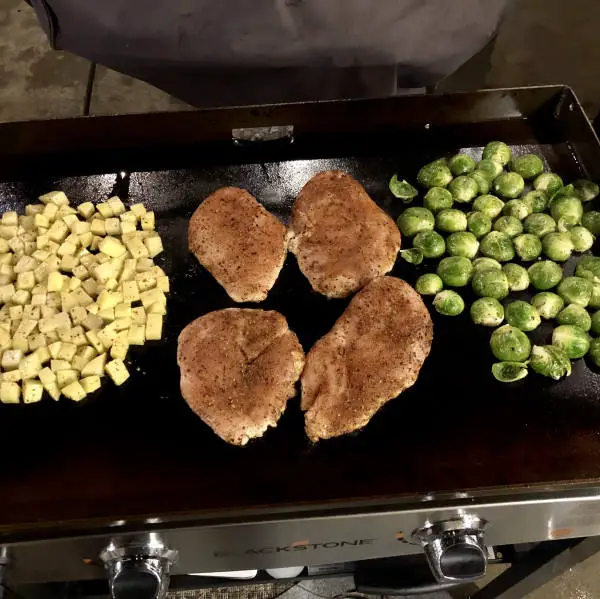
Flat top grills are highly versatile, much more than grills.
This means that you can cook much more foods, including:
- Rice
- Pancakes
- Small vegetables
- Eggs
- Stir-fry
- Haystacks
to name a few.
See this exhaustive list for other foods.
Don’t Go Full Blast When Preheating
Preheating a flat top is just as essential as preheating a pan, grill, oven, etc.
Usually, when preheating, we tend to increase the temperature to the max to start cooking as soon as possible.
But if you did this here, you might end up warping the cooking surface (the risks are higher when it’s cold outside).
Set the temperature to medium or medium-high to be safe. You can also start on low and gradually increase the temperature.
Most foods don’t require high heat anyway.
Clean & Season It Regularly
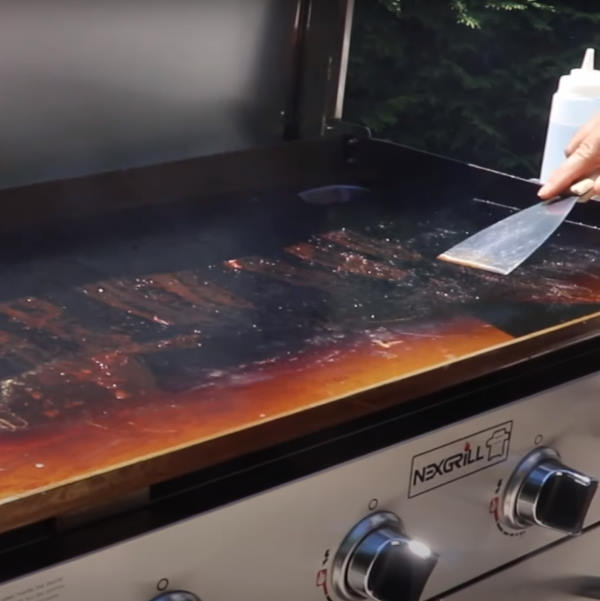
A clean flat top grill is a happy flat top grill.
Regular cleaning increases the grill’s lifespan, prevents food from sticking, and prevents cross-contamination.
See this guide on how to do it fast and easily. It includes tons of different methods, brands, and flat top materials so everyone should find it useful, regardless of which grill they have.
Don’t forget to season it afterward to prevent rust.
It’s not hard: just add a little bit of oil, spread it with a paper towel across the entire griddle (sides included), and turn on the flat top on high until you see smoke. Then turn it off and you’re done.
Don’t Waste Money on Specific Cleaners
There are tons of griddle-specific cleaners on the market that do a great job but the truth is you don’t actually need them.
A scrapper and some water are more than enough in most cases.
You’ll save plenty of money in the long run.
Hack Your Grease Tray
Grease trays need to cleaned and emptied on a regular basis, as well, and because they’re small, they fill up pretty fast.
If you don’t do this, they’ll overflow, wreaking havoc on your deck, patio, backyard, etc. They can also attract all manner of bugs and insects.
One option is to use disposable drip trays that are aluminum trays that you put in the grease tray and throw them away once you’re done cooking.
They’re surprisingly cheap and abundant – you can get them at most big-box stores.
In a pinch, you can also add a few sheets of aluminum foil.
Another one involves a bit more work but it will last for a very long time: drill a hole in the tray, put a hose in and fix it, and place a bucket underneath:

Recycle Bacon Grease
Cooking bacon can get really messy – all that grease and oil.
Instead of throwing it away, use it to season your grill.
Put Any Solid Debris Right Into the Grease Tray
Many flat tops have the grease drain and tray at the front. The hole above the tray is in many cases not that big.
In this case, if you shove everything into the drain (food particles included), you might clog the drain, the hole, or both.
This will result in a huge mess, as the drain will overflow, soaking the grill, the floor, and possibly you with grease.
Avoid Using Abrasives
Don’t use things like steel wool on the flat top because there’s a high chance you’ll scratch the surface and remove seasoning and any potential rust protection coating applied at the factory.
Always Add Oil Before Cooking
Even if you seasoned it, you should add oil before cooking.
This is because if you don’t, you’re more likely to burn your food.
It doesn’t matter which oil you add.
Know Your Temperature
Low, medium, and high heat. You should know the difference between them.
If you set the temperature too low, the food will be more raw than cooked. If you set it too high, you’ll burn it.
Unlike regular grills that come with a lid thermometer, flat tops don’t come with either.
You’ll need to get a separate thermometer. I tried several types of thermometers but I found out that an IR gun works best.

You can use it on other things, as well, making it highly versatile.
Knowing this is really important because different foods require different temperatures.
For example, eggs and pancakes are better cooked on low to medium while steaks and veggies should be cooked on high.
See this temperature chart for more info.
Turn It off a Couple of Minutes Before Finishing Cooking
Flat top grills take a while to cool down.
Instead of turning it off after cooking, do it a couple of minutes before. The griddle will be hot enough time until you finish cooking.
I do it about 5 minutes before and the food always turns out great. It was never undercooked because of this.
Take Advantage of the Prep and Storage Space
This tip applies only (more or less) to freestanding models since most portable and tabletop versions don’t have either.
Side shelves, cabinets, hooks, and racks are there for a reason: so you’ll have everything you need within arm’s reach.
Have a Tray Nearby
It doesn’t matter what kind, price, or material.
When cooking on a flat top grill, there’s always going to be plenty of stuff to carry, clean, store, etc.
Instead of carrying everything awkwardly in your hands like this guy:

Place your stuff on a tray carry it like a decent human being.
There’s Nothing Wrong With Placing a Pan on the Top
You can even make sauces, soups, or just boil water on your flat top.
You’ll need a pot or a pan for this because if you try cooking these directly on the grill, they will drain directly into the grease pan.
Be aware that it takes a bit longer than it would on the stove.
Grill in Two Zones
This tip works only for flat tops that have at least 2 burners.
A two-zone cooking area is an area that has a direct and indirect cooking zone.
A direct cooking zone has the burner underneath lit while the indirect zone doesn’t.
Having an indirect zone is ideal for warming up food that you already prepared so it doesn’t get cold while you prepare the rest of the meal.
Have a Paper Towel Holder? Fix It in Place
It’s really awkward when you have both of your hands dirty and you really need a paper towel because you’ll have to hold the holder with one hand while tearing a sheet with the other.
This can get messy.
You can prevent this from ever happening and make your life a little easier if you fix the paper towel holder in place.
It doesn’t really matter how you do it. You can either screw it somewhere on the porch or get yourself a magnetic holder that snaps directly onto the grill itself.
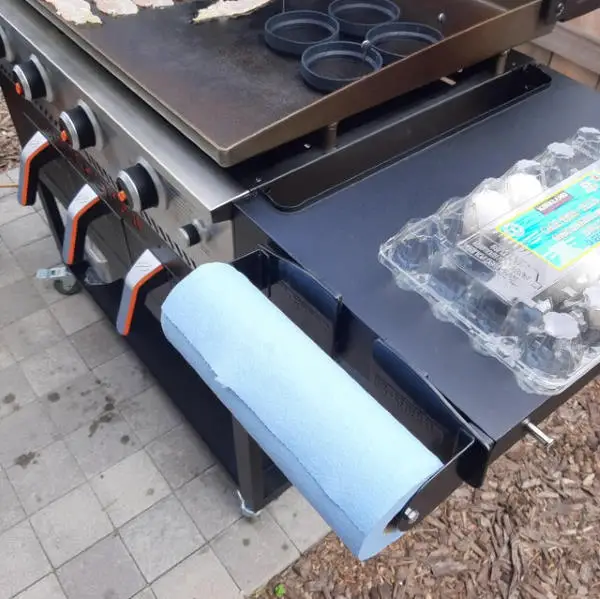
Always Be Near the Grill While Cooking
Fight the urge to check your e-mails, Facebook/Meta, a YouTube video, and other things that take your attention away from the griddle while cooking because there’s a high chance you’ll burn the food.
I learned this the hard way and had to say goodbye to several juicy homemade burgers I was craving for several days but didn’t have the time to do them before.
Check You Gas Tank Regularly
One of the worst things that can happen to you during a BBQ is running out of gas.
I learned this the hard way.
There are several ways to check how much gas you have left in the tank:
- Pouring warm water on the tank
- Install a fuel gauge
- Weight it and substrach the weight of an empty tank (a full tank weighs about 37 lbs: 20 lb propane + 17 lb tank)
Alternatively, you can have an extra tank so you’ll swap at a moment’s notice.
Check for Leaks From Time to Time
Regulators and hoses have a shelf life and get bad over time.
They can crack and/or break over time, with constant use, and adverse weather conditions like really high and low temperatures, humidity, and exposure to direct sunlight.
Checking for leaks is really simple, fast, and won’t cost you a dime.
You just need soapy water and a spray bottle (if you don’t have it, use a brush or a paper towel). Spray the solution across the hose, regulator, and tank to see if there are any bubbles forming.
If there aren’t, you’re good to go.
Immediately Stop Cooking Once You Smell Gas
If you smell gas, this means there’s a leak, and you should stop cooking immediately.
Gas leaks aren’t a joke and can result in a fire, explosion, or both.
Check for leaks, fix/replace the broken parts, check for leaks again, and only then resume cooking.
Invest in a Warming Rack
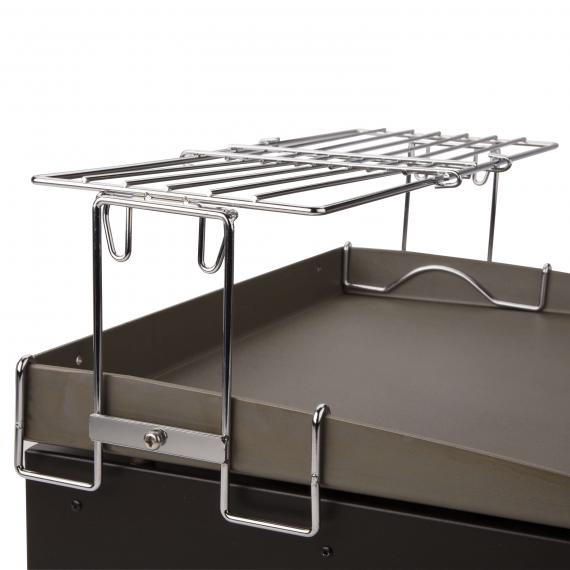
Warming racks are awesome.
They increase the grill’s total cooking area (you have more space to cook with), are ideal for toasting buns, bread, veggies, and other dishes.
But unfortunately, flat tops don’t come with one, unlike many grills.
Fortunately, though, they are really cheap and cost anywhere form a few bucks to $30.
Store It in a Cool and Dry Place
When you have finished cooking on the grill (and, of course, cleaned it), you shouldn’t leave it in the open exposed to the elements.
Sooner than later, the whole thing will begin to rust and break apart.
If you want to keep using your flat top as long as possible, you should store it in a cool and dry place, and cover it.
Make Use of Squeeze Bottles
They are great for storing things like oil, ketchup, mustard, and various BBQ sauces.
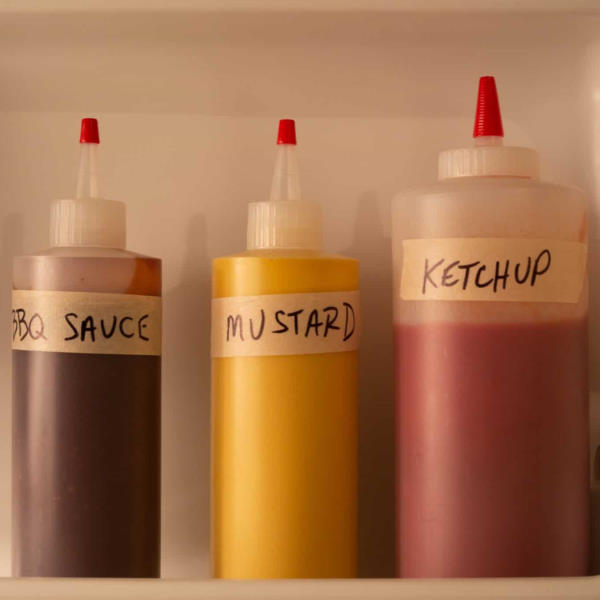
I have a separate bottle of water that I use for cleaning.
These bottles are way more convenient than having your sauces and condiments in a bowl or jar.
Also, you’ll have fewer dishes (i.e. spoons and bowls) to clean.
Keep Your Kids Away From It
Keep your kids away from the griddle for the same reason you keep them away from the stove – so they don’t get hurt.
Only once they know how to handle the grill properly, have them nearby.
Avoid Cooking Indoors if You Have a Gas Model
Gas flat top grills should only be used outdoors.
Cooking inside your home poses several risks, including carbon monoxide poisoning, fires (grills aren’t insulated as ovens are), and explosions (gas builds up fast in a closed space and having an open flame nearby is a recipe for disaster).
Don’t Place Anything Flammable Near the Grill
This one is a no-brainer but deserves a mention.
Stuff like paper, cardboard, and plastic shouldn’t be near the grill.
You can place plastic bottles, utensils, and similar things on the side shelves but place them on the oposite side so they’re as far away from the heat as possible.
Conclusion
Cooking on a flat top grill looks like straightforward and simple but it has more depth to it.
By following these cooking tips and techniques, you’ll master the art of cooking on a flat top grill and become a pro griller in no time.
Did I forgot something? Mention your own tips, tricks, techniques, and hacks in the comment section below.

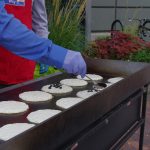
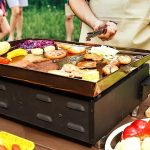
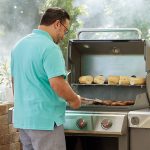
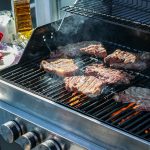
Thank you so very much for the time and trouble you took to educate newbies to the gas/griddle/braai cooking.
Just bought a Blackstone griddle. So far steaks have turned out great and had some left over smoked pork rib from the Traeger refried with peppers, onions, cheese and melts on tortillas unbelievable. Can’t wait to cook breakfast. Thanks for your tips.